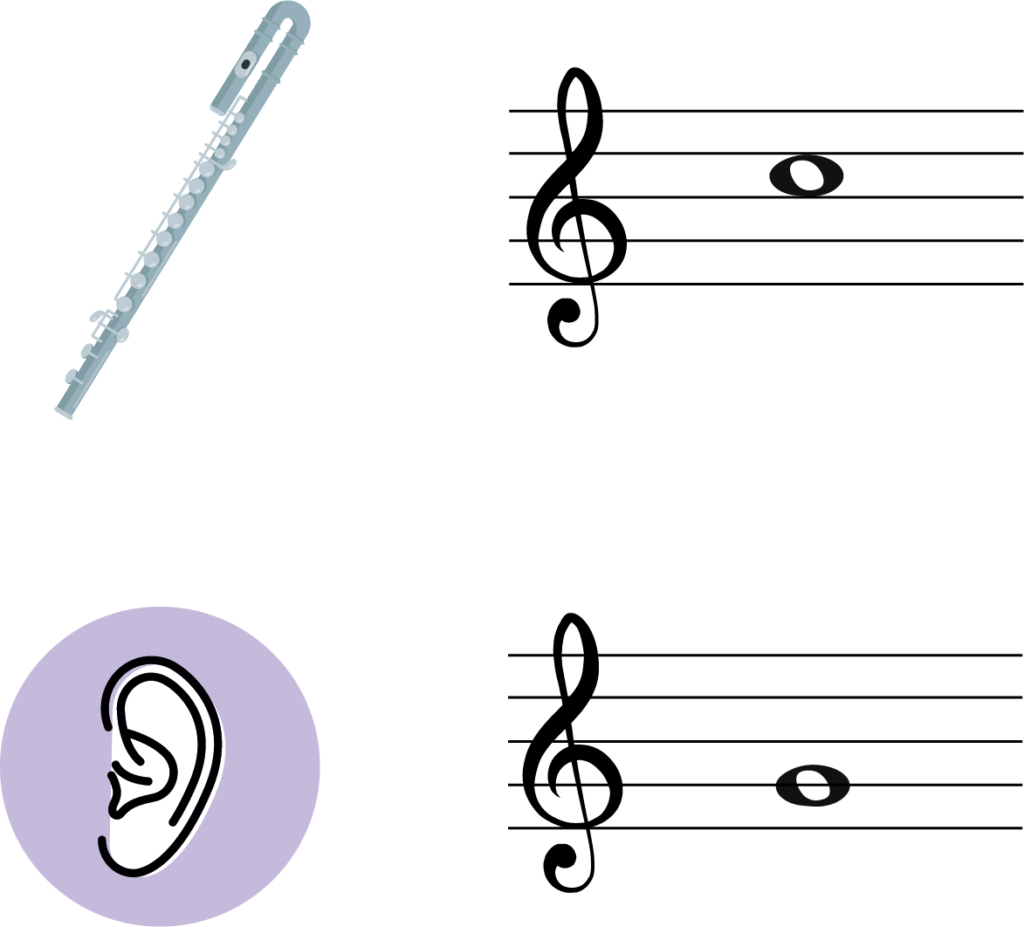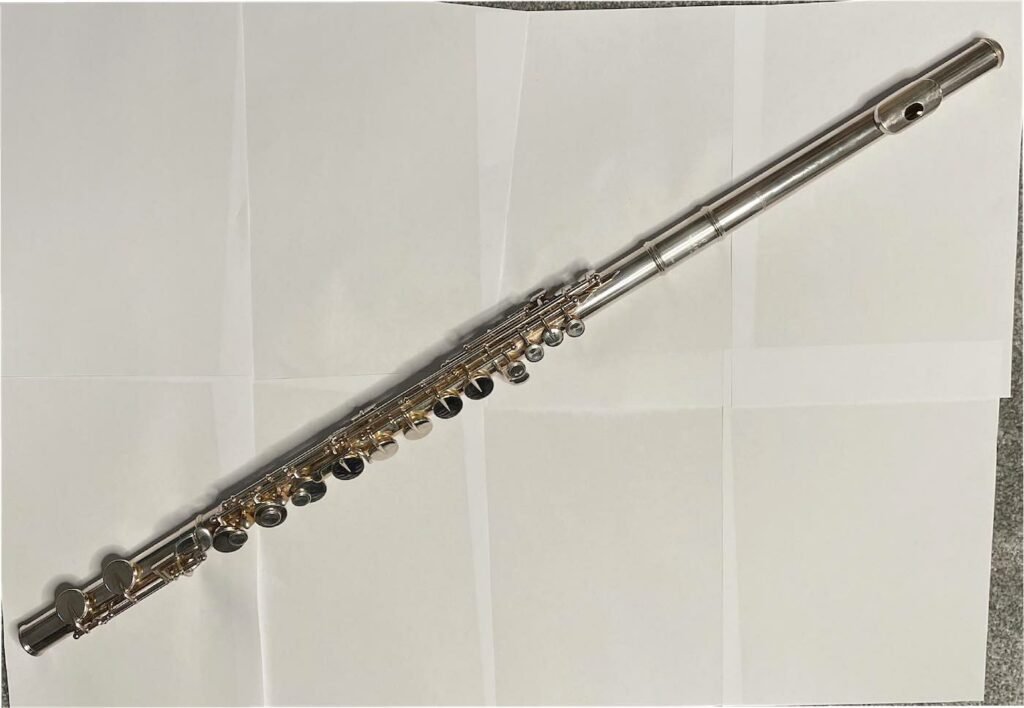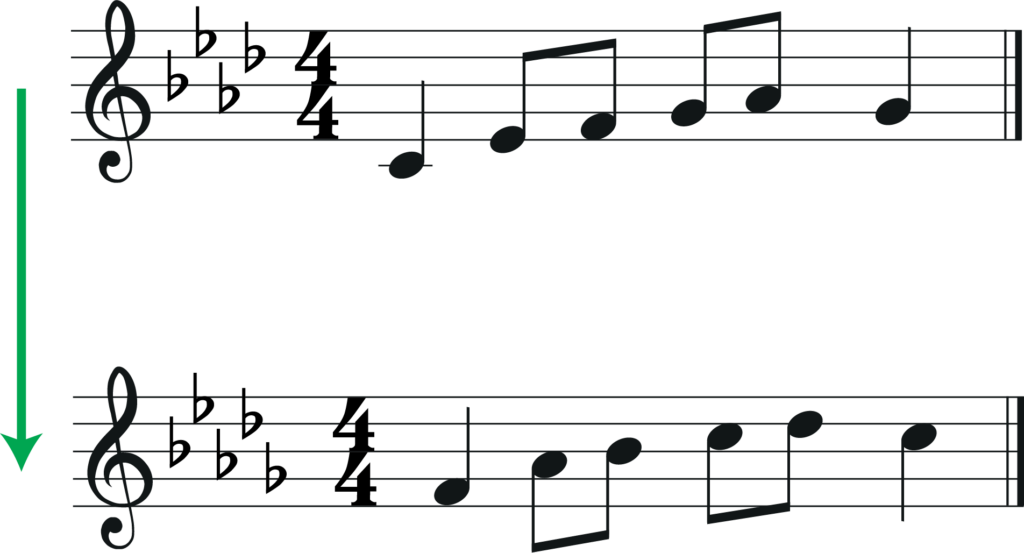The alto flute is a beautiful instrument that belongs to the Western flute family. It is the second-highest member, below the standard C flue, after the uncommon flute d’amor. It has a range from G3 to G6 and is characterised by a rich, mellow tone in its lower range. It uses the same fingerings as the C flute and piccolo, but it is a transposing instrument in G.
In this article, we will explain how alto flute transposition works in different situations. By the end of it, you’ll be able to transpose with confidence!
The Alto Flute in G
One of the challenges of playing the alto flute is transposing the music written for other instruments. Transposing means changing the pitch of a piece of music to make it fit the range or key of another instrument. The Alto flute is a transposing instrument in G. This means that when the alto flute plays a C on the staff, we hear the G below this, or perfect fourth below.

If you want to play a piece written for the C flute on the alto flute, you have to transpose it up a perfect fourth to make it sound at the same pitch level.

Transposition chart for the Alto Flute
Here is a handy chart for helping you with alto flute transposition. You can use it to transpose a single note: For example to play a concert pitch C you would need to play the F above on the alto flute. Or you can use it to transpose the key signature of a piece. For example a piece in D Major would transpose up a perfect 4th to be played in G Major on the alto flute.

Transpose G to C
The alto flute, unlike other flutes, is a transposing instruments. This means that when a player reads a C on the staff and play a C, we hear the G below. In other words, their written pitch is a perfect 4th above their sounding pitch.
If you play the alto flute and you want to compose music that harmonises with the piano, your sheet music will be a perfect 4th above the notes on the piano’s sheet music (or any other non-transposing instrument). This would work the same if you wanted to write different flute parts to harmonise with the alto flute.
Or you may want to play an alto flute piece on your regular flute. In this case you will have to lower each note a perfect 4th (5 half-steps). This will ensure it is heard in the same key as the alto flute.
Steps to Transpose G to C
Transposing from G to C involves up moving the notes up 5 half-steps (semitones) or 2½ whole-step (tone). This is the same as moving up an interval of a Perfect 4th as C natural is the 4th note in the F major scale.
There are two different methods of alto flute transposition from G to C.
Method 1- Move notes up one at a time
Have a look at the melody below.

The melody is written in key of D major. We could move all the notes up a 5 semitones, making sure that we take into account the F# and C# notes in the original key.

Here is the new melody. As you can see, we now have one sharp, so we are in the key of G Major.

Method 2 – Transpose the key signature
- We could move up all the notes up a 4th
- Transpose the key signature up a perfect 4th
- Deal with any notes outside the original key
Look at the melody below.

It is in Ab major so we have Bb, Eb, Ab and Db. First let’s move all the notes up a 4th. Intervals always include the starting note so in effect, this means moving up three positions on the staff.

Now we can transpose our key signature. A perfect 4th above Ab is Db. Another way to put this is that D flat is the 4th note of the A flat major scale. So our new key signature is D flat Major, which has five flats.
Here is our transposed melody with the new key signature.

Here is the full transposition.

If there were any accidentals that were outside the original key of Ab, we would not use this method. Instead we would treat these as individual notes and transpose them on their own. So if we had a C# then this would move up to an F# (5 half-steps above).
How to Transpose C to G
We can do alto flute transposition the other way round, from the alto flute’s written pitch down to sounding pitch. This would be used if you have an alto flute pieces that you would like to write harmonising pieces for. You will be able to work out which key non-transposing instruments need to be.
Steps to Transpose C to G
Below is a melody in G major, with one sharps in the key signature. If this music is written for the alto flute, then we can transpose down a perfect 4th to find the sounding pitch.

We could transpose each note, one by one, but this would take a long time. Instead I am going to follow the Method 2 steps from above.
- We could move up all the notes down a 4th
- Transpose the key signature down a perfect 4th
- Deal with any notes outside the original key
Below is the original melody moved down a 4th. As we count the note we start on this means moving down three steps.

Now we need to transpose our key signature. A perfect 4th below G is D. This is because G natural is the 4th note of the D major scale. D major has two sharps, F# and C#.
Here is our transposition completed.

Using computer software
A far quicker method of alto flute transposition is to use software to do it for you! Apps like Musescore, Sibelius and Finale will transpose whole pieces with the press of a few buttons. You can then export, print and share your new transposed sheet music.
What’s next….?
- Get the perfect flute tone with our guide to perfect intonation.
- See our list to the top 10 flute players ever!
